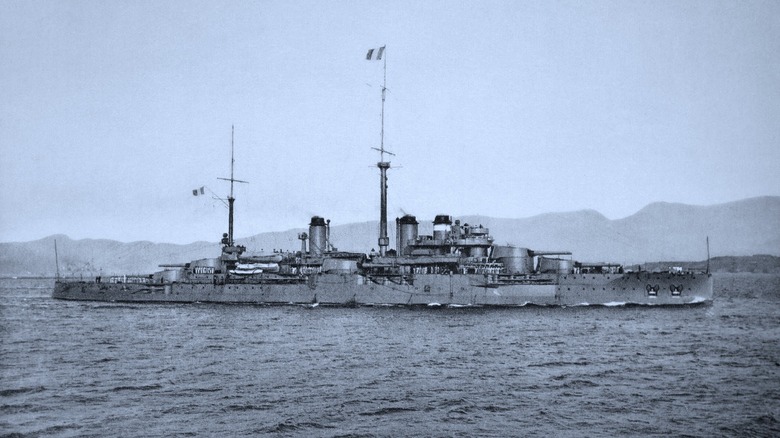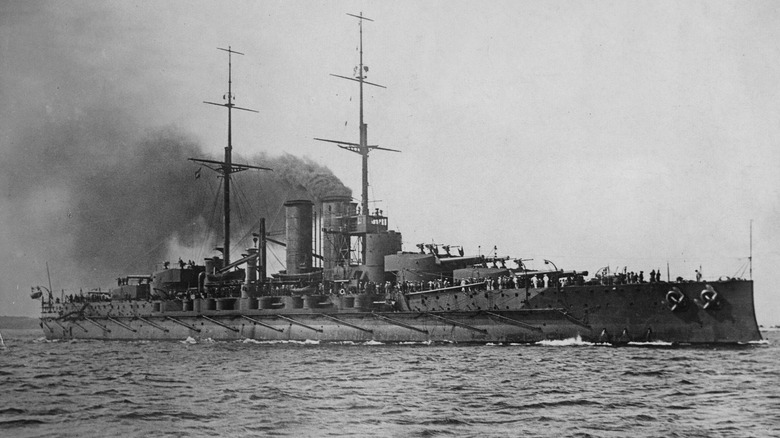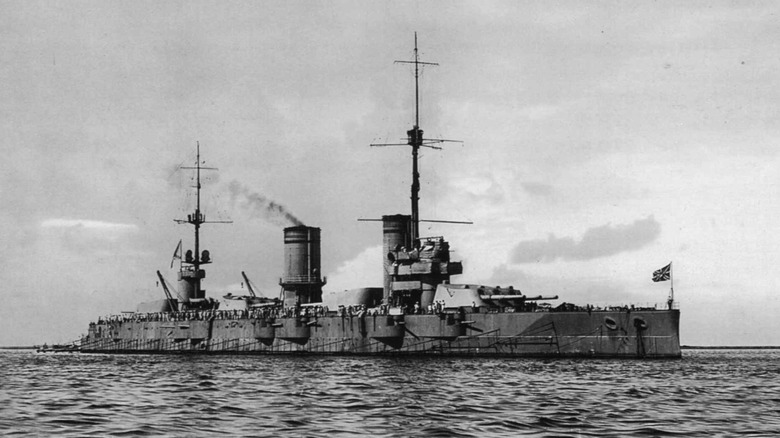5 Of The Worst Battleships In Military History
When it comes to history, it's typically the most legendary ships that are highlighted. But at the other end of the spectrum, certain warships didn't exactly make the grade. Sometimes there were design flaws, while other times it's as simple as a ship not receiving the chance to prove itself. With a plethora of battleships that have seen combat, it's difficult to figure out exactly which were the absolute worst, but more than a few have made headlines, giving us a good idea of where to start.
Battleships were the flagship vessels of navies across the globe from 1860 until about the end of World War II. These large ships combined a strong defense with an especially powerful offense, armed with cannons that could hit targets up to 20 miles away with impressive accuracy. As time went on, though, the world's navies gradually phased battleships out of their fleets, and they're not among the seven types of modern warships. Aircraft carriers , especially nuclear carriers that can stay at sea for months without refueling, have taken over the battleship's role as fleet flagships, with the added benefit of fighter aircraft being launched from them.
France's Courbet class was undergunned
While the other European nations were adding dreadnought-class battleships to their navies in the lead-up to World War I, France stubbornly put most of its effort in developing its Danton-class battleship. This put the nation behind other navies by five years. France eventually turned to its first dreadnoughts, the Courbet class — the Courbet, Jean Bart, France, and Paris. While these had better armor than the Danton class, they were still behind the standards of the time, built with a dozen 305 mm guns like previous French vessels while other nations were using 343 mm guns.
The first two of the Courbets were operational in 1913, but none of the ships saw much action when the war came the following year. The Jean Bart was damaged by a submarine-launched torpedo at the end of 1914, though it was repaired.
Nearly a decade later, the France crashed into a reef and sank. The remaining three battleships underwent some modernization, but even that wasn't good enough to put them on level footing with other battleships. They continued using 305 mm guns while others in 1939 were using 356 and 406 mm guns. Their anti-aircraft weaponry left something to be desired, as well.
The remaining Courbets were eventually used as training vessels by 1939. The last surviving battleship in the class was the Courbet, which was sold off to be scrapped in 1947.
[Image by Marius Bar via Wikimedia Commons | Cropped and scaled | PDM 1.0]
Austria-Hungary's Tegetthoff-class had a weak underside
The Austro-Hungarian Navy wasn't large, but it was innovative and a common threat to the Italian Navy. The Tegetthoff-class consisted of four battleships: The Tegetthoff, the Szent Istvan, the Viribus Unitis, and the Prinz Eugen. These battleships introduced triple turrets to the world, emphasizing the Austro-Hungarian Navy's innovation and its investment in the class's weaponry. Unfortunately, that investment came with a steep cost. Focusing too much on the class's guns, the Navy failed to construct the ships with reliable armor, specifically underwater. The Tegetthoff-class's defense under the waves consisted of a 1.9-inch anti-torpedo bulkhead, which really only kept vital machinery safe.
It's possible that the Navy knew about this weakness because for much of World War I, the Tegetthoff-class remained inactive. There was a brief skirmish in the Austro-Hungarian port of Pola in which Italian torpedo boats took advantage of this weakness and sank the Szent Istvan in 1918. Later in the same year, Italian frogmen snuck into Pola's harbor to place a portable mine on the Viribus Unitis' hull. This capsized the battleship, leaving only two in its class. Italy received the Tegetthof after the war only to scrap it in 1922, while the Prinz Eugen went to France, where it was used for target practice.
Russia's Gangut class was poorly designed
Russia ordered four Gangut-class battleships in 1909, but financial issues delayed construction until 1911, and the Gangut, Petropavlovsk, Poltava and Sevastopol didn't enter service until 1914 and 1915. By this time the Gangut class was already obsolete, compared to the vessels other countries were using to fight during World War I.
While battleships were designed to devastate an adversary's navy, they were also supposed to be well-armored, to take a beating if necessary. But Russia must have been a fan of the "best defense is a strong offense" mentality, because it sacrificed armor in favor of more firepower. These battleships were armed with four turrets with three 12-inch guns on each, while their 8.9-inch armor was insufficient. Design flaws with its barbette guns left them lacking in range and power, and placed too low, so that in rough weather foam would obscure them.
When World War II came about, the only battleships in the Soviet Union's fleet were the three remaining, refurbished Gangut-class battleships — the Poltava suffered a massive fire at its dock in 1919 and was never repaired – all with new names. Needless to say, these ships made little to no impact in any combat they encountered. None was afloat after the '50s.
[Featured image by Unknown author via Wikimedia Commons | Cropped and scaled | CC PDM 1.0]
HMS Vanguard was a ship out of time
Great Britain's HMS Vanguard wasn't necessarily a bad battleship. There was some design choices that other countries might have done differently — Vanguard was built with 15-inch guns while U.S. and HMS Nelson-class battleships were outfitted with 16-inch guns – but it could have been an impressive ship had it received an opportunity. It's one thing to build the last battleship, but it's something entirely different to build the last battleship when everybody else already stopped making them. Perhaps the British didn't get the memo, but aircraft carriers were capable of much more than battleships and were considered the way of the future.
It wasn't that the Vanguard wasn't well-built — it was just late to the party. The Royal Navy commissioned it in 1946, a year after World War II came to an end. The battleship found itself serving as a flagship during a time of peace when it was built to be in the thick of combat. King George VI used the Vanguard as a yacht during his 1947 to South Africa and in 1953 took part in a review of ships as part of Queen Elizabeth II's coronation. It's like the U.S. creating Captain America and using him to sell war bonds. The Royal Navy decommissioned the Vanguard in 1960, only 14 years after it started its service. It could have been great, but it was late to the party.
USS Massachusetts (BB-2) couldn't handle the sea
If the United States used the USS Massachusetts (BB-2) as an example of its military might, the country might not puff out its chest too often. This battleship was an embarrassment of epic proportions that deserves its own "The Office"-style sitcom.
The Massachusetts, an Indiana-class battleship commissioned in 1896, served along America's Eastern Seaboard until 1898, when it was called south to Cuba and Puerto Rico for the Spanish-American War. It wasn't much to look at, but it did seem strong enough to handle anything war and the ocean threw at it, armed with 13-inch cannons, 6- and 8-inch guns, four Gatling guns, and six torpedo tubes. Unfortunately, it wasn't much good out on the open sea.
The battleship couldn't take on high waves, and when its 13-inch cannons turned, their weight forced the ship to list in that direction, with the deck and other cannons sinking below the water line. That shouldn't have been surprising, since the total weight of the four 13-inchers was roughly 272 tons. The Massachusetts also ran aground on two separate occassions, and nine sailors died during a training exercise when one of the 8-inch guns exploded.
By 1910, the Massachusetts was relegated to a training vessel for the Naval Academy. The Navy decommissioned it in 1919 and at the end of its service, it became a manmade reef off the shores of Pensacola, Florida, where fish and other aquatic life could use it as a home.





